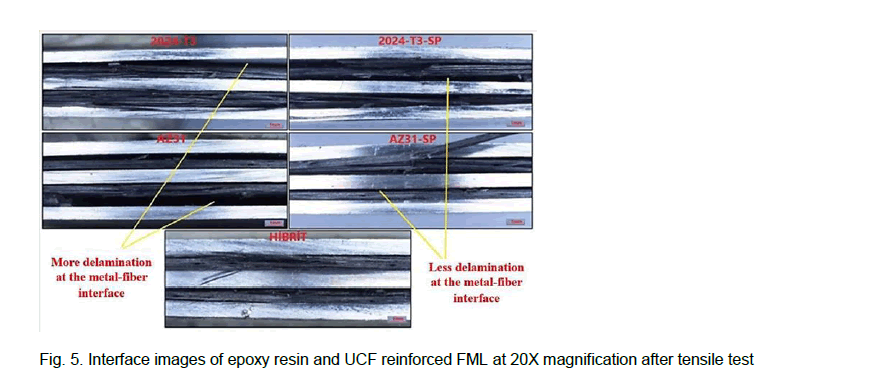
"AN INVESTMENT IN KNOWLEDGE ALWAYS PAYS THE BEST INTEREST" BENJAMIN FRANKLIN

"AN INVESTMENT IN KNOWLEDGE ALWAYS PAYS THE BEST INTEREST" BENJAMIN FRANKLIN

Short Communication - (2021) Volume 58, Issue 3
Received: Dec 08, 2021 Published: Dec 29, 2021, DOI: 10.36962/gbssjar/58.3.005
In this study, 0.8 mm thick 2024-T3 aluminum sheet and AZ31 magnesium sheet are used as metal matrix elements. Laminated composite materials were produced in a hot press device after stacking (Metal/Prepreg/Metal/Prepreg/Metal) in the order of 3/2 stack by using carbon fiber and epoxy resin as the reinforcement phase between the metal matrix elements. After the composite materials were produced, tensile tests were carried out and optical microscopy analyzes were carried out to determine the damage mechanisms that occurred later.
Composite material, 2024-T3 aluminum sheet, AZ31 magnesium sheet, Tensile tests, Epoxy resin.
The matrix and reinforcement phases that make up the composite materials exist as components. This system of components, which can have very different combinations in terms of diversity, allows the development of optimum combinations while designing composite materials and the production of composites specific to the intended use. Fiber metal layered composite materials are hybrid composite materials produced by combining fiber-reinforced polymeric materials into thin metal sheets.
Fiber Metal Laminated Composites (FMLs) are a group of materials widely used in industries due to their superior properties such as light weight, high strength / weight ratio, excellent fatigue performance and impact resistance. FMLs are made of thin metal layers of these materials, can be aluminum, magnesium or some steels. Composite layers of FMLs reinforced with glass, aramid or carbon fibers in various thermoset or thermoplastic resins and this part has higher strength and hardness than monolithic sheet.
Experimental study
Material production: In this study, 0.8 mm thick 2024-T3 aluminum sheet and AZ31 magnesium sheet are used as metal matrix elements. Laminated composite materials were produced in a hot press device after stacking (Metal/Prepreg/Metal/Prepreg/ Metal) in the order of 3/2 stack by using carbon fiber and epoxy resin as the reinforcement phase between the metal matrix elements. The sequence and symbolic representation of the composite produced is shown in Figure 1.

Figure 1: Symbolic representation of 2024-T3 Aluminum and AZ31 magnesium matrix and Epoxy Carbon Fiber reinforced laminated composite
In addition, in order to improve the interface properties of aluminum and magnesium sheets used in this study with epoxy resin, shot peening was applied to metal sheets with 6 glass powders at 30 psi pressure, 10 sec duration, and 0.18 mm intensity parameters. This process was applied to the inner surfaces of the metal plates forming the outer 2 layers of FML and to both surfaces of the plates forming the middle layer.
Tensile test: Tensile test has been applied to determine the mechanical properties of the produced laminated composites. The tensile test was carried out according to ASTM D3039 in the MTS brand 100 kN tensile device at a tensile speed of 1 mm/min. Tests were carried out by extracting 3 tensile samples of 1 x 10 cm from each laminated composite plate. Tensile test specimens were obtained by cutting from the main plate in a precision cutting device. Visual of these operations can be seen in Figure 2.

Figure 2: The tensile test systems Note: a) The device where the tensile tests of the samples were carried out, b)The sample preparation process, c) The sample under the tensile test
Optical analysis: NIKON brand shuttle pix portable digital stereo microscope was used to examine the interface properties of the produced samples after the tests applied.

Figure 3: Tensile test results of AZ31, 2024-T3 used in the production of FML and the double-surface shot peening of these plates
Figure 4 shows the tensile strength of FML produced with Unidirectional Carbon Fiber (UCF) and epoxy resin reinforcement.

Figure 4: Tensile test results of Unidirectional Carbon Fiber (UCF) and epoxy reinforced FML
The highest value with a tensile strength value of 1013.9 11.2 Mpa belongs to the composite produced with 2024-T3 aluminum sheets treated with shot peening. When the graphic is examined, it has been determined that shot peening has increased approximately 25% in composites produced with AZ31 magnesium plates and 6% in composites produced with 2024-T3 aluminum plates. The tensile strength of the hybrid composite produced by 2024-T3/UCF-Epoxy/AZ31/UCF.
Epoxy/2024-T3 stack combination is very close to the tensile strength values of composites produced with 2024-T3 plates. The use of 1 equally thick magnesium sheet between 2 aluminum sheets provided approximately 15% reduction in total composite weight, while there was no significant decrease in tensile strength.
The effect of the mechanical locking mechanism at the metal fiber interface has a direct positive effect on the mechanical properties. In Figure 5, the images taken from the damaged areas of the samples after the digital microscope tensile test show that the amount of delamination occurring after the tensile test in the metal fiber interfaces of FMLs produced with metals exposed to shot peening is much less than the samples produced by the punching process. The same is true for hybrid FML.

Figure 5: Interface images of epoxy resin and UCF reinforced FML at 20X magnification after tensile test
Within the scope of this study, FMLs with 3/2 stack order were produced by reinforcing carbon fibers with epoxy resin between 0.8 mm thick 2024-T3 aluminum and AZ31 magnesium plates. As a result of the experiments, the results shown below were obtained.
• Sanding and shot peening processes applied to improve the adhesive properties of metal sheets made the surfaces rough enough for lamination. It has been found that shot peening is more successful than sanding in this regard.
•With the effect of shot peening applied to metals, the tensile strength of AZ31 magnesium plate, whose both surfaces are treated, increased by 30%, and the tensile strength of 2024-T3 aluminum plate increased by 15%. The main reason for this increase in strength is thought to be the deformation hardening of metals and permanent compressive stresses on the surfaces due to shot peening.